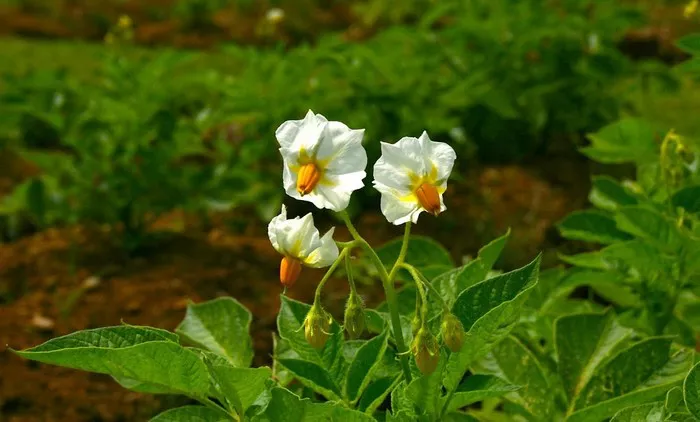Potatoes are a staple food worldwide, appreciated for their versatility and nutritional value. Yet, beyond their culinary importance lies a fascinating botanical phenomenon: flowering. While not all potato plants produce flowers, those that do often evoke curiosity and wonder. In this article, we delve into the intricacies of why potatoes flower, exploring the biological, environmental, and agricultural factors that contribute to this phenomenon.
Understanding Potato Growth
Before delving into the flowering of potatoes, it’s essential to understand the plant’s growth cycle. Potatoes belong to the Solanaceae family and are herbaceous perennials grown as annuals. They undergo distinct stages of growth, starting from sprouting eyes to developing tubers underground. Throughout this process, environmental cues play a crucial role in influencing the plant’s development.
Environmental Triggers
One of the primary triggers for potato flowering is photoperiodism, the plant’s response to changes in daylight length. Many potato varieties require specific day lengths to induce flowering. Typically, potatoes are categorized into two groups based on their photoperiodic response: long-day and short-day varieties.
Long-day potatoes initiate flowering when daylight hours are more extended, typically in regions with higher latitudes or during the longer days of spring and summer. Conversely, short-day potatoes flower when daylight hours are shorter, often in regions closer to the equator or during the shorter days of autumn and winter.
Temperature also plays a significant role in potato flowering. While potatoes are adaptable to various temperature ranges, optimal temperatures for flowering typically range between 60°F to 70°F (15°C to 21°C). Extreme temperatures, either too hot or too cold, can inhibit flowering or affect the quality of flowers produced.
Furthermore, soil moisture, nutrient availability, and other environmental factors influence the overall health and vigor of potato plants, indirectly affecting their flowering capacity.
Botanical Significance of Potato Flowers
Potato flowers serve a crucial botanical purpose in the plant’s reproductive cycle. Like other flowering plants, potatoes rely on pollination to produce viable seeds for reproduction. The flowers attract pollinators such as bees, flies, and beetles through their vibrant colors and sweet nectar.
Upon successful pollination, potato flowers develop into small green fruits containing numerous seeds. While these seeds are not commonly used for potato propagation due to the vegetative nature of potato cultivation, they play a vital role in maintaining genetic diversity within the species.
Agricultural Implications
From an agricultural perspective, understanding potato flowering has practical implications for farmers and growers. Flowering can serve as an indicator of the plant’s developmental stage, signaling the onset of tuber formation and eventual harvest.
Additionally, flowering can impact crop management decisions, such as the timing of fertilization, irrigation, and pest control measures. Farmers often monitor flowering patterns to optimize yields and ensure the health and productivity of their potato crops.
Furthermore, some potato varieties are bred specifically for their flowering characteristics. Breeders select for traits such as flower color, size, and abundance to enhance ornamental value or attract specific pollinators, thereby promoting natural biodiversity in agricultural landscapes.
Cultural and Culinary Significance
Beyond its botanical and agricultural importance, potato flowering holds cultural and culinary significance in various regions worldwide. In some cultures, potato flowers are admired for their beauty and incorporated into floral arrangements or decorative displays.
Moreover, potato flowers are symbolic of the plant’s life cycle and the promise of a bountiful harvest. In folklore and traditions, they are often associated with abundance, prosperity, and fertility, reflecting the vital role potatoes play in sustaining communities and economies.
In culinary contexts, potato flowers are occasionally used as garnishes or edible decorations in dishes, adding visual appeal and a subtle floral flavor. While not as commonly consumed as the tubers themselves, potato flowers offer a unique culinary experience for adventurous cooks and food enthusiasts.
Conclusion
In conclusion, the flowering of potatoes is a multifaceted phenomenon shaped by biological, environmental, agricultural, and cultural factors. Understanding why potatoes flower provides valuable insights into plant physiology, reproductive biology, and agricultural practices.
From the plant’s perspective, flowering is a crucial step in its reproductive cycle, facilitating pollination and seed production. For farmers and growers, monitoring flowering patterns helps optimize crop management strategies and maximize yields. Culturally and culinarily, potato flowers hold symbolic and aesthetic significance, enriching traditions and culinary experiences.
As we continue to explore the complexities of potato cultivation and consumption, let us appreciate the beauty and significance of these humble yet extraordinary plants and the wonders of nature they embody.


